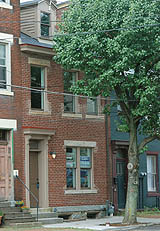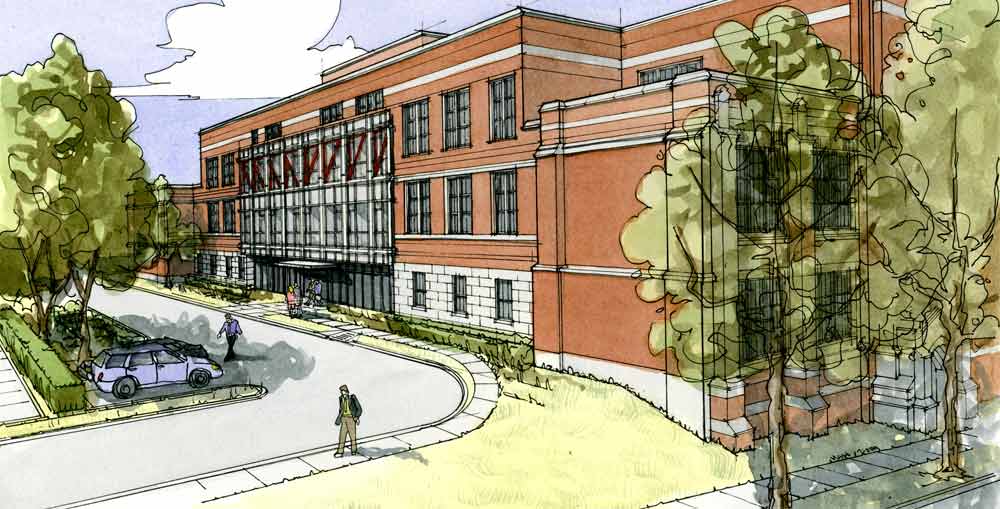
Category Archive: Preservation News
-
Roxian (Theater) Ready for Start of Renovation
Thursday, July 29, 2010By Brian David, Pittsburgh Post-GazetteWhen Andrew Hieber saw a “for sale” sign on the Roxian Theater in McKees Rocks, he had an instant vision.
A musician, he knew the local concert scene. A longtime restaurant worker, he knew entertainment. As the owner of a martial arts and fitness gym, he knew business. As a native of The Rocks, he knew what lower Chartiers Avenue had once been. And as a lucky early investor in America Online stock, he even had a bit of money.
“I had always looked at the Roxian as a great music venue,” with nice acoustics and a size that slotted neatly between the clubs and the stadiums, he said. Built in the late 1920s as a movie theater and used for every conceivable stage show since, the Roxian was well-worn but structurally sound. Mr. Hieber figured he could slap on some paint, work his connections and start bringing in mid-level touring bands.
That was 2004. The vision has taken a couple of beatings since. “I don’t get excited anymore,” Mr. Hieber said. “I got really excited five years, six years ago, and it just got me frustrated.”
But if he starts feeling the rush again, it is excusable — the grand old theater is in the process of being gutted in the first phase of a renovation that should have it open by next year.
The plan is to open a side wall to create space for ticket booths and a new entrance, refurbish the main floor with a new bar area and removable seats, raise the stage for safety and better sightlines and replace the 285 balcony seats with 225 seats sized for modern rear ends. The building is also getting an elevator, new wiring, plumbing and ventilation systems, new bathrooms and new light and sound systems.
In all, the cavernous space — five floors on a 27,000-square-foot footprint — will be able to hold 1,500 for a concert, but also will be able to function café-style for banquets, receptions and smaller shows.
In some ways, all this is possible because of the first beating that was administered to Mr. Hieber’s dream six years ago.
When he inquired about buying the building, he was put in touch with an old Sto-Rox schoolmate, Taris Vrcek, who had recently taken on leadership of the McKees Rocks Community Development Corp. Mr. Vrcek told him the Community Development Corp. was acquiring the building and already had someone lined up to be owner/operator of the theater business.
But he promised to keep Mr. Hieber atop the list if anything happened, and when the original operator bailed out six months later, he gave Mr. Hieber a call.
The next blow came when Mr. Vrcek said the community corporation would rent him the building, but would not sell it.
“I said, ‘Why should I rent it from you when I can own it myself?’ ” Mr. Hieber said. “But he waved the carrot of nonprofit grant money in front of my nose.” The Community Development Corp. could get the kind of support that no for-profit business could.
The final blow made the necessity of that arrangement clear; architectural studies showed that to meet code, the theater would need an elevator and bathrooms with 42 toilets, far beyond what it had. “That kind of tore down my dream,” Mr. Hieber said.
Mr. Vrcek, however, was undeterred. He had a strong vision of what lower Chartiers could be, and the redeveloped Roxian was “the game-changer, the catalyst for the rest of the strategic plan,” he said.
“Bring 1,000 people in here several times a week, imagine what that would do. It would really give us a chance to market some beautiful old buildings.”
The neighborhood already has Hollowood Music Center, a music store with a regional clientele, and the Roxian is catty-corner from the Father Ryan Arts Center, a nonprofit facility that supports visual and performing arts.
Mr. Vrcek sees other clubs and restaurants sprouting, capitalizing on the arts-centered theme. “The Roxian could really make this a destination of choice,” he said.
Mr. Vrcek spent years obtaining a $500,000 grant from the state Department of Community and Economic Development and a $250,000 county grant. He also brought in Dennis Stasa, owner of the McKees Rocks company Penn Interiors, as a private partner. The company is doing the renovation work and will have an ownership stake.
Mr. Hieber described Mr. Stasa as “a visionary” when it comes to the building’s interior. “He’s sure when he’s done with this that he’s going to end up on the cover of Pittsburgh Builder magazine.”
The full flow of Mr. Stasa’s vision may have to wait a while, though. Mr. Vrcek said the focus for now is on getting the building ready for effective use as a concert venue, with the “extra bells and whistles” to follow as money is available.
That puts the current focus on the building’s mechanicals and on bringing the main floor and main stage up to standards.
The “bells and whistles” could be a lot of fun, though, because the building is a maze of half-hidden rooms, like a real-life “The Phantom of the Opera” set.
There are rooms flanking the stage along the back wall, stacking up to the ceiling. These were delicately referred to as “sleeping rooms” in the theater’s club days and could be used as “green room” space for artists.
Mr. Hieber envisions opening a small restaurant in a room above what is now the entrance and a cigar bar in an identical room above that. There’s a lounge between the two entrances that was, until recently, adorned with hanging beads and disco posters. The projection room still holds the original projectors — huge machines from the dawn of the movie era.
And then there’s the basement, a huge space previously used as a sports and dance bar; Mr. Hieber envisions a similar use in the future.
“I’ve been through the building probably 20 times,” Mr. Hieber said, “and every time I find a new space I didn’t know about.”
And standing in the empty, dusty darkness of the main floor, he betrayed the fact that the excitement really is still there.
“It’s going to be awesome,” he said.
-
Rural Freeport Theatre Festival Finds Success Turning History into Drama
Thursday, July 15, 2010By Kate Luce Angell – Pittsburgh Post-Gazette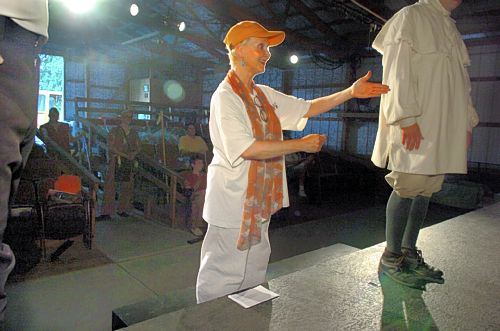
Marushka Steele directs actors in a dance scene in the play "Battle of Kittanning" set in 1756 and written by her husband Rennick Steele. Bill Wade/Post-Gazette
The brainchild of Rennick and Marushka Steele, the Freeport Theatre Festival in Allegheny Township is celebrating its 21st season this summer, an accomplishment by any standard.
But what makes its success even more significant is that, in these increasingly tough economic times for arts organizations, the Freeport Theatre Festival thrives by going against much of the conventional wisdom for successful small theaters.
Instead of concentrating on popular scripts, the festival specializes in history plays — often local history — and often written by Mr. Steele as well as other local playwrights.
The Steeles also chose to found the festival in a rural area, almost 45 minutes from Pittsburgh and its theatergoers. Their performance space, a converted machinery barn, sits on White Cloud Farm in Armstrong County, on land that has been in Mr. Steele’s family for generations.
Mrs. Steele attributes much of the success to the company’s focus on serving the people of the area. “We respect our audience, and they love history,” she said.
“Cauldron of Steel,” Mr. Steele’s play about immigrants in Vandergrift at the turn of the 20th century, is playing until July 25.
Starting Aug. 13 is the final play of the summer season, “Bertha and Bailey’s Circus,” a comedy also by Mr. Steele.
How Mr. Steele, who with Mrs. Steele was involved in New York City’s Off-Off-Broadway Alliance of the 1970s, decided to return to his family’s farm and found the Freeport Theatre Festival is another story that goes against expectations.
Mr. Steele lived on the farm until age 15, when his family relocated to Columbus, Ohio. He earned a bachelor’s degree in English from Ohio State University, served a stint in the Army and then moved to New York to become a professional actor and playwright.
“It was an exciting time,” said Mr. Steele of the 1970s, adding that the rules for mounting low-budget productions were much looser then, allowing him to produce several of his own plays with professional casts.
He met Mrs. Steele, then Marushka Dembecki, who had come from her hometown of Detroit to try her luck as a ballet dancer and as a professional actress. They married in 1980.
The Steeles left New York for Los Angeles in 1983, where Mr. Steele earned a master’s degree in education at the University of California at Los Angeles.
His father had returned to the family farm after his retirement and the Steeles joined the family there in the late 1980s. They founded the Freeport Theatre Festival in 1989.
Mr. Steele said he had found his family’s own long history in the area to be a rich source of inspiration for his plays.
Of Scotch-Irish background, the Steeles moved to the Hannas Town and Mount Pleasant area in the 1770s, later settling near Freeport.
Adjacent to the Steeles’ property is a cemetery dating from when a church stood nearby; the Steeles that are buried there “populate my plays,” Mr. Steele said.
For example, he said, “the town doctor in ‘Cauldron of Steel’ is my grandfather’s first cousin, whose stone is up there.”
In its early years, the festival concentrated on popular plays by known names, but in 1995, Mr. Steele presented a full-length play about a forebear of his mother’s, a Native American woman whose name was Nancy Ward.
“Beloved Woman” proved that historical drama could be a hit, and was the first of the festival productions to make use of historical re-enactors — people who take on roles of historical figures.
On June 17, Mr. Steele retired from his job as seventh grade teacher in the Armstrong School District, and he says he looks forward to dedicating even more time to the festival. The Steeles are both in their 60s.
Operating as a nonprofit, the festival is lucky in that it hasn’t yet had to raise ticket prices, Mrs Steele said.
“We break even. Three-quarters of our funds come from ticket sales, the rest from our corporate and individual sponsors.”
The couple is in the middle of a fundraising campaign to improve the performance space and add “real restrooms.”
The Steeles also plan a return to some of their more ambitious productions of the past, plays like “The Battle of Kittanning” that employed large casts, outdoor locations and even, on occasion, the farm’s horses and sheep.
“The Battle of Bushy Run will have its 250th anniversary in 2013,” noted Mrs. Steele. “My husband has said that in 2012, he’ll write a play about it.”
Bushy Run was an important 1763 battle during the French and Indian War that took place near Harrison City in Westmoreland County.
What has become clearer than ever over the years, said Mrs. Steele, is the power of both history and theater to remind us of our connections to our communities and each other.
“We’re all part of the same human family. And art helps us see that.”
Details: www.freeporttheatrefestival.org.
-
Vandergrift Moves to Preserve Look of Borough Property
By Rossilynne Skena
VALLEY NEWS DISPATCH
Monday, July 26, 2010Borough residents who cut down trees between the sidewalk and the curb could face a fine.
Those trees are borough property, officials say.
A new ordinance would enforce that by prohibiting residents from trimming or removing trees along the street — even those in front of their house.
Councilwoman Kathy Chvala leads the borough’s tree committee, which includes two other council members and four residents.
Chvala said the fine for a resident cutting down a tree along the street has not been determined.
She said the property owner would be billed for the cost of replacing the tree.
She expects council to consider the matter in September.
Chvala said she’s heard mostly positive feedback.
The only negative feedback she’s heard is from people who want to have a tree cut down when it’s healthy.
“We really want to maintain what we have,” she said.
But council president Brian Carricato said “trees are a very touchy issue in town.”
It’s not just residents who want to cut down healthy trees that they don’t want. He said but others insist on keeping dying trees standing.
Mayor Lou Purificato said property owners cutting trees down on their own doesn’t happen often.
Carricato said the committee wants to keep the town looking the way it does.
“The last thing you want to do is drive down a street with trees and now they’re all cut down,” he said.
Chvala remembers beautiful fall foliage along Vandergrift’s curved streets.
“There was a time that there was twice as many trees in town,” she said. “Probably more than that.”
Chvala likes to see healthy trees bloom again in the town with colorful autumn leaves.
Removing dead trees
While trying to save healthy trees, the borough has awarded a contract with a tree service to clear out the dead ones.
By fall, the tree committee will start placing those trees with healthy ones.
M&M Tree Service of Apollo has been awarded a contract worth between $4,500 to $5,000 for tree removal or trimming, Chvala said.
Nine types of dead trees will be removed along Hancock Avenue, West Adams Avenue, East Adams Avenue, Sherman Avenue, and Lafayette Street.
Eleven trees along Hancock Avenue, Sherman Avenue, Jefferson Avenue, Harrison Avenue, Franklin Avenue and Lafayette Street will be trimmed.
The tree committee is looking for donations, Chvala said. Anyone who is interested in donating should contact the borough secretary at 724-567-7818.
Contributing writer Dale Mann contributed to this report.
-
Foundation Offering Money to Help Churches Pay For Repairs
By Jodi Weigand
PITTSBURGH TRIBUNE-REVIEW
Monday, July 26, 2010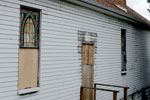
Stained-glass windows at First Baptist Church of Glassport were vandalized Thursday. The church hopes to obtain help from the Pittsburgh History & Landmarks Foundation's Historic Religious Properties Program to make repairs. Jasmine Goldband | Pittsburgh Tribune-Review
A small Glassport church might have to pay thousands of dollars to replace antique stained-glass windows broken by vandals.
“They were all handmade,” said the Rev. Ira Kelly, co-pastor of First Baptist Church of Glassport. “They’re as old as the church is, and now they’re lying here on the floor in pieces.”
In addition to the heartbreak of losing the four 100-year-old windows in the sanctuary late last week, the congregation is suffering sticker shock. Replacements could cost as much as $12,000, Kelly said. That’s a tall sum for the 25-member church, he said.
In a twist of fate, the vandals hit shortly after the Pittsburgh History & Landmarks Foundation announced the revitalization of a program that could help the congregation pay for the damage. After two years of struggling to fund its Historic Religious Properties Program, the foundation said, an influx of donations has helped raise more than $100,000 for grants to assist churches in paying for renovations.
“We all felt it was an overwhelming response from our contributors,” said Carole Malakoff, coordinator for the foundation’s religious properties fund. “We were really thrilled at how this (fund drive) turned out.”
Due to a lack of money, the foundation had not awarded any religious property grants this year and gave just $32,000 in 2009, she said. Typically, the fund yielded about $75,000 a year in grants.
The recent fundraising push began three months after the foundation’s annual appeal netted just $22,000. Two members offered a $25,000 challenge grant, to which the foundation added a challenge grant of $12,500. The campaign ended last week with 288 gifts totaling $62,710.
Churches in Allegheny County that are more than 50 years old can apply for a grant of up to $10,000 to be disbursed in 2011. It’s a matching grant, meaning that if a church gets $5,000, the congregation must raise $5,000 to match it.
Malakoff said she has fielded calls from numerous church leaders seeking money to repair gutters and roofs damaged in February’s record snowfall. The foundation gets about 35 formal applications a year from churches seeking grants.
This year, the foundation has limited the scope of work to exterior renovations, including stained-glass windows, roofs, gutters and masonry work, Malakoff said.
“Those are big issues with historic properties,” she said.
Since 1997, the foundation has awarded about $700,000 in grants, which resulted in about $2.4 million in work on 100 historic religious buildings. Many churches raise money above and beyond the required matching funds, Malakoff said.
The foundation wants to keep the tradition going by establishing an endowment for permanent funding of the religious properties program, she said.
“We look at them as the major cornerstone of a community,” Malakoff said. “Many of these buildings are used for all kinds of community outreach programs. They’re of utmost importance to the community.”
On the WebApplications for grants through the Pittsburgh History & Landmarks Foundation’s Historic Religious Properties Program are available online at phlf.org.
For details about a September technical assistance workshop for churches planning renovations, e-mail Carole Malakoff at hrp@phlf.org.
-
Buying Here: Deutschtown
Saturday, July 17, 2010By Kevin Kirkland, Pittsburgh Post-GazetteEven by North Side standards, 621 Tripoli St. was a challenge.
The original 1890s brick townhouse was intact, but the later wood-frame addition on the back was crumbling and falling away, and raccoons had made themselves at home. Worst of all to an old-house lover, someone had cut into the front facade and installed a picture window, probably in the 1970s.
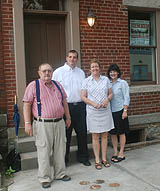
Members of the Northside Leadership Conference, from left, are Bernard Beck, president of East Allegheny Community Council; Greg Jones; Nancy Noszka, director of real estate for the Northside Leadership Conference; and Teekie Smith, Coldwell-Banker agent. Larry Roberts/Post-Gazette
The window is history now, as is the early 20th-century addition, replaced by a new wood-frame rear section containing the kitchen, part of the dining room and a second-floor bedroom. The two-bedroom, 11/2-bath house is on the market for $219,900 through Teekie Smith of Coldwell Banker Real Estate’s Shadyside office (412-708-1588 or www.pittsburghmoves.com, MLS No. 826966).
Ms. Smith says the house is a perfect blend of old character and new amenities.
 Deutschtown:
Deutschtown:
At a glance- Website: www.deutschtown.org
- Size: .236 square miles
- Population: 2,635 (2000 census)
- School district: Pittsburgh Public, www.pghboe.net
- Enrollment: about 28,000
- Average SAT scores: 358 verbal; 383 math; 362 writing (2009, Oliver High School)
- Taxes for a house assessed at $100,000: $2,941; County: $469 (4.69 mills); City: $1,080 (10.8 mills); School: $1,392 (13.92 mills)
- Wage tax: 3 percent (1 percent to the city, and 2 percent to the school district)
- A bit of history: Deutschtown — also known as East Allegheny and Dutchtown — dates back to the mid-1800s and grew as the City of Allegheny expanded eastward. As its name implies, it was once the heart of Pittsburgh’s German-speaking community. It is still headquarters for the 150-year-old Teutonia Maennerchor, the largest German singing society and social club in the region. The neighborhood was added to the National Register of Historic Places in 1983.
“The developers have tried their hardest to preserve anything original,” she said. “The hardware is wonderful. There are locks and latches that I’ve never seen before. But it’s also got new floors, air conditioning, a second-floor laundry, off-street parking [two spaces] and a big backyard.”
This is the fifth project in the past 10-15 years involving the Northside Leadership Conference and East Allegheny Community Council, says Greg Jones, project manager for the Northside Leadership Conference. Al Depasquale and October Development were the general contractors on this renovation and another at 517 Tripoli. Mr. Depasquale is also the developer and contractor on three new houses going up around the corner on James Street.
In late 2008 and early 2009, October Development finished building three new brick houses and renovating two old ones in the 900 block of James. The three new townhouses sold for $229,000 each and the old ones for $190,000 and $165,000, respectively.
“The new ones sold before construction,” Mr. Jones noted. “The speed and price were unprecedented in this area.”
This part of the North Side is usually called East Allegheny or Historic Deutschtown in recognition of its large German population in the late 19th century. It was divided by construction of the Parkway North in the 1980s. Many century-old brick townhouses remain, along with more modest wood-frame dwellings. Some have been renovated, but not as many as in nearby Allegheny West and the Mexican War Streets, where houses are generally more expensive.
Mr. Jones said buyers are fairly evenly divided between young professionals and older empty-nesters, many of whom are familiar with the North Side and its historic yet affordable housing stock.
“They say, ‘My friend bought one in this neighborhood.’ It’s a limited supply but a heck of a market. They often sell by word of mouth,” he said.
“These people have an interest in historic restoration. They know what they’re getting into. They get a house with some character that has a story to it.”
Adding to the attraction is a 10-year abatement on city and school property taxes and a three-year abatement on county taxes that can save buyers as much as $30,000 to $40,000, he said. Depending upon income, they may also qualify for a second, deferred mortgage, Ms. Smith said.
The home at 621 Tripoli is unusual in that it was renovated with no public subsidy through funding from the Northside Community Development Fund. The design/build process used reduced the need for an architect and sped construction. Luckily, many of the old doors and much of the hardware and trim were reusable, as was the original staircase and mantels on the two decorative fireplaces. Preservation expert Nick Kyriazi, a longtime member of the East Allegheny Community Council, even came up with old lighting fixtures for the first floor.
“They were restored and rewired. They’re stunning,” Ms. Smith said.
Although the front parlor and floor plan were retained, the new rear section is very open, with granite countertops in the new 13-by-13-foot kitchen. The new powder room is tucked away nearby, and the large modern bathroom upstairs serves bedrooms measuring 17 by 15 feet and 17 by 13 feet, respectively, each with large closets. The developers opted to make the third floor a storage area rather than living space (the ceiling height is only about 6 feet).
The East Allegheny Community Council bought the property for $9,900 in June 2008, and its assessed market value is $9,000 (www2.county.allegheny.pa.us). Five properties have sold on Tripoli in the past three years for prices ranging from $17,500 in July 2009 to $215,000 in September 2009 for the October Development rehab at 517 Tripoli. One property sold twice (www.realstats.net).
This house is three blocks away from Allegheny General Hospital and Allegheny Commons Park and 5-10 minutes waking distance from Downtown, Heinz Field and PNC Park. An open house will be held from 1 to 4 p.m. this Sunday and next Sunday.
-
170-Year-Old Tavern in Menallen to Serve Up the Past
By Mary Pickels
TRIBUNE-REVIEW
Thursday, July 22, 2010
Fayette County Historical Society President Jeremy Burnworth is in the restored main room on the second floor of the former Abel Colley Tavern, which will is the society's headquarters. Barry Reeger | Tribune-Review
The Fayette County Historical Society Friday will hold a grand opening of its museum, to be housed in the former Abel Colley Tavern in Menallen.
Open to the public, the 3 p.m. program will showcase the restored red-brick structure at 7083 National Pike.
Last July, Warren and Virginia Dick of Smithfield donated the 170-year-old building to the historical society. Volunteers helped to restore the property, which is listed on the National Register of Historic Places.
Society President Jeremy Burnworth credited volunteer Tom Buckelew and former intern Bill Zinn, along with inmates from the State Correctional Institution at Greene, who performed labor through the Community Works Program, for much of the renovation.
Community volunteers pitched in to paint walls, install moulding and restore hardwood floors.
Although some work remains, the majority of the main rooms have been restored, Burnworth said.
Photos to be displayed Friday will show the “before” and “after,” he said. “You will be able to see (the volunteers’) accomplishments in a short amount of time. We want to let people see the beautiful work that has been done.”
Additional work will help take the structure to its next level, becoming a museum, Burnworth said.
“It’s Fayette County’s first-ever historical museum,” he said. “It’s kind of a big deal.”
Friday’s program will include local government officials, Dick family members and representatives from the National Road Heritage Corridor and the Sen. John Heinz History Center. The historical society is an affiliate of the history center and may benefit in the future through a display of Civil War memorabilia, Burnworth said.
In the future, the site will be used for the society’s headquarters. It will be available for fundraisers and meetings.
Donations of historical artifacts pertaining to Fayette County are welcome.
“They can go way back, 50 to 250 years old,” Burnworth said. “For example, think of veterans.”
There has been no place in the county to display photos, uniforms, letters or furniture, he noted.
“We are afraid people will be throwing things away,” he said. “We really want a situation in place, so even if family members are not interested, we can protect and archive (those items). We get lots of calls for information, requests to come to the building and look at the archives and all of the things people think we have.”
Plans include a gift shop, likely to include publications and books on the region’s history. In acknowledgement of the building’s history, keepsake mugs will be sold on Friday.
Public visitation hours have not been set.
“The committee will help determine the direction of ‘what’s next,'” Burnworth said.
For more information, or to donate or volunteer, visit the society’s website at www.fayettehistory.org. Anyone interested in attending Friday’s opening or joining an advisory committee is asked to call 724-439-4422.
-
Neighbors in the Strip Accredited as a National Main Street Program
Wednesday, July 21, 2010
Pop City Media
Neighbors in the Strip, a non-profit organization dedicated to promoting economic development in the Strip District, has been awarded designation as an accredited National Main Street Program by the National Trust for Historic Preservation.
The prestigious designation is based on a ten point set of criteria, which ultimately demonstrates that an organization has leveraged local historic and business assets to thoroughly promote revitalization of a neighborhood business district.
Neighbors in the Strip was formed in 1999 by stakeholders wishing to better promote economic transformation in the neighborhood, while maintaining its historic character. A decade ago, “the perception of crime in the strip was very high,” notes Becky Rodgers, Executive Director of NITS. “Looking back over the past ten years, with a lot of hard work from the police, the DA’s office, and the stakeholders, crime has decreased in the Strip by 58 percent. If you want to keep economic development happening, you have to keep crime down.”
In addition to making the neighborhood safer, NITS works with local proprietors to promote business. In fact, forty new businesses are scheduled to open soon, including a public market, which will be opening in August.
“We’re mainly zoned urban-industrial in the Strip, which is sort of the wild west of zoning,” says Becky. “So when a new project comes along, there are certain zoning exceptions that have to go in front of the zoning board, and we go with business owners to the board to support those variances.”
Other factors that lead to the Main Street designation include NITS’ strong cooperation with its partners, which include the City, the URA, and a large number of non-profits, as well as the substantial grant programs they offer. Neighbors in the Strip has played a key role in helping the neighborhood evolve into a residential area in the 2000’s, aided by their Upper Floor Grant, which encourages the residential development of underutilized floors above commercial businesses.
Sign up to receive Pop City each week.
Source: Becky Rodgers, Executive Director of Neighbors in the Strip
Writer: John Farley -
Old School Steps to Front of the Class
By Eric Heyl
PITTSBURGH TRIBUNE-REVIEW
Wednesday, July 21, 2010Consider it a textbook example of how to transform a dilapidated eyesore into a potential community jewel.
For nearly a quarter-century, the former South Hills High School in Mt. Washington slowly deteriorated while various redevelopment proposals were about as successful as the initial Hindenburg launch.
As recently as 18 months ago, the enormous 155,000-square foot building occupying an entire city block at the corner of Ruth and Eureka streets stood empty and decaying.
Surrounded by an imposing chain link fence, the old school appeared as though it never would be anything more than a refuge for birds seeking shelter through the holes in the roof.
Since then, the scene has changed dramatically.
“We’ve come a long way,” Victor Rodriguez said Tuesday, standing in the vicinity of where the principal’s office used to be. “I think this is pretty monumental in terms of what we’ve accomplished.”
Rodriguez is senior vice president of a.m. Rodriguez Associates, which purchased the building from the city’s Urban Redevelopment Authority two years ago for $1. Given the structure’s condition at the time, Rodriguez might have overpaid for it.
But following a $23 million makeover that included $10 million in public money, the structure will reopen in about six weeks as the South Hills Retirement Residence.
The place is proving popular among the senior crowd even before the first tenants move in. As contractors scurry to apply the finishing touches, 42 of the building’s 106 units have been leased.
Rodriguez yesterday provided me a tour of the building, the inside of which looks virtually nothing like it did when the Class of ’86 closed the school for good.
Although some of the original hardwood and ornate metal railings were incorporated into the interior design, it’s unlikely the 2,200 members of the school’s alumni association would recognize the place.
That’s a good thing.
Rodriguez removed several unsalvageable portions of the former school, including the auditorium and the swimming pool, while adding amenities the 94-year-old building desperately needed — elevators and air conditioning.
In addition, a portion of the building is expected to house medical offices, which should further increase foot traffic in what had become a desolate neighborhood. An early childhood development center also might occupy some space.
“What we’re striving for here is something community-changing,” Rodriguez said.
Joshua “J.T.” Smith, board president of the Mt. Washington Community Development Corp., lives about two blocks away and is thrilled with how the place looks.
“For years, that building created a real negative mood with all of that prison-style fencing around it,” he said. “It’s great to walk by now and see something vibrant and alive, with the new trees and the clean sidewalks. This is going to alter the mentality of the whole neighborhood.”
Again, it’s a textbook example of transformation.
For an old school, what could be more appropriate?

